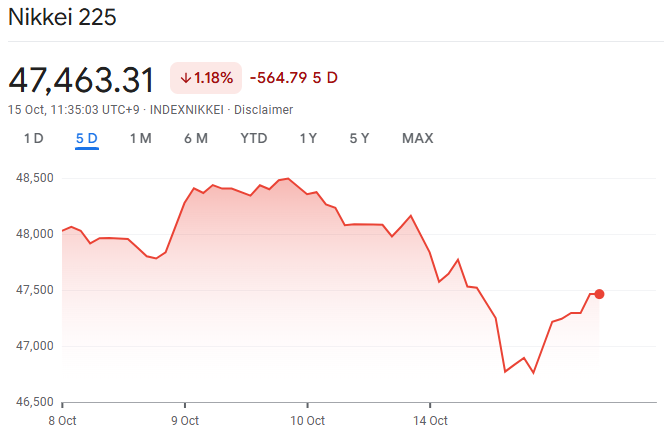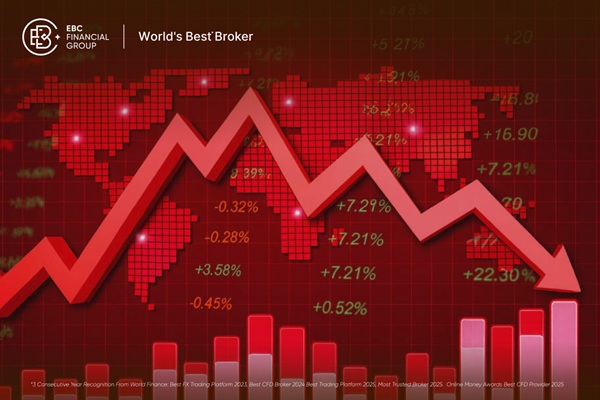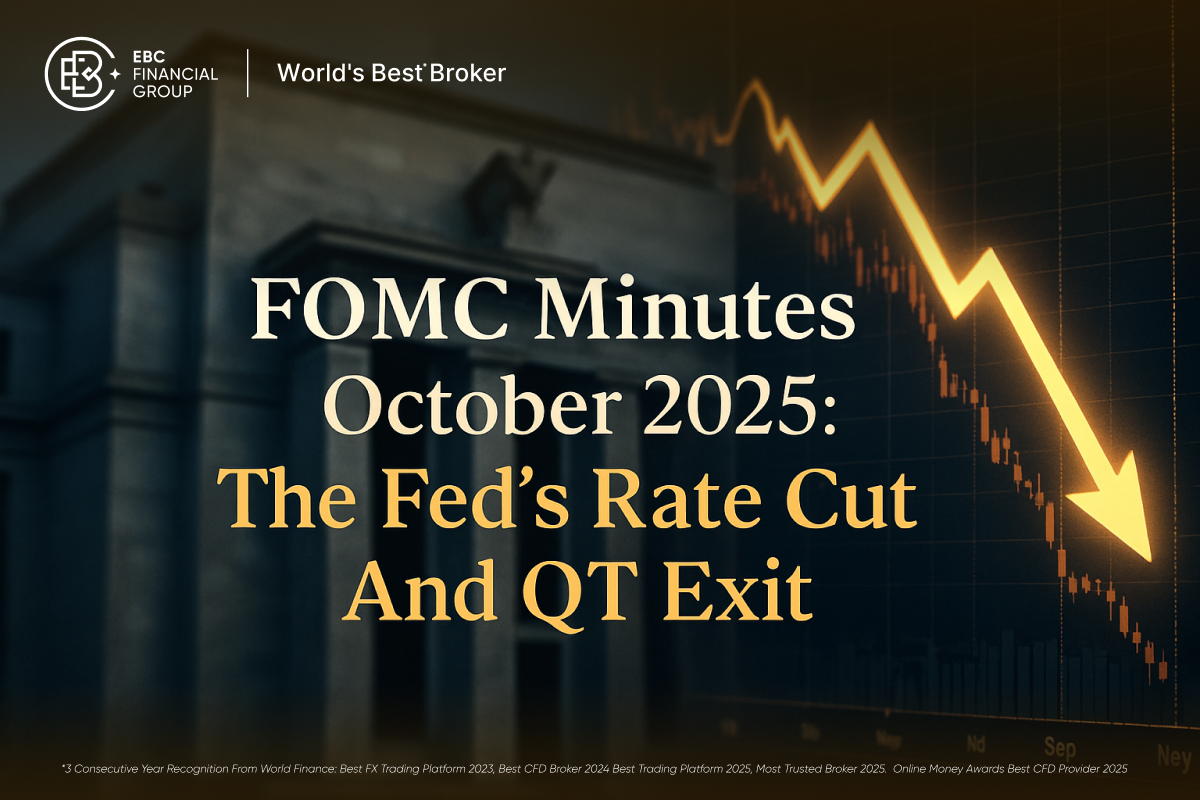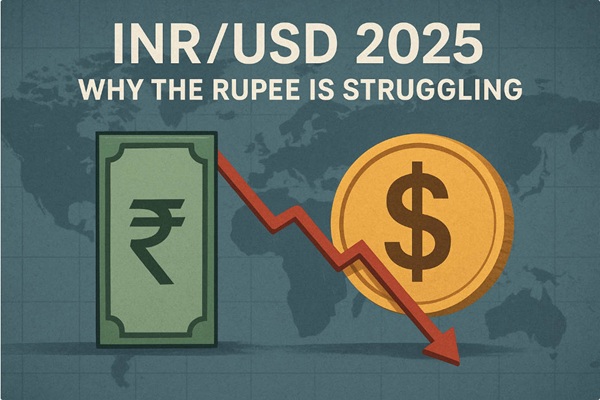Japan's Nikkei 225 plunged 1,407 points, or 2.93%, to close at 46,847 on 14 October in its worst single-day decline since April, driven by the shocking collapse of Japan's ruling coalition.
The selloff came after Komeito, the Liberal Democratic Party's junior partner for 26 years, announced late Friday it would leave the coalition, throwing into doubt whether newly elected LDP leader Sanae Takaichi can secure enough votes to become prime minister.
The announcement unwound the so-called "Takaichi trade," erasing a euphoric rally that had driven the Nikkei to record highs above 47,000 just days earlier.
Nikkei's 'Takaichi Trade': From Record High to Crash

On 6 October, the day after Sanae Takaichi won the LDP leadership contest, the Nikkei surged 4.75% to close above 47,000 for the first time in history.
Investors celebrated Takaichi's pro-growth platform, which promised increased government spending, lower borrowing costs, and policies that would discourage the Bank of Japan from raising interest rates.
| Metric |
Pre-Coalition Collapse (Oct 6–10) |
Post-Collapse (Oct 14) |
Change |
| Nikkei level |
47,089 (record high) |
46,847 |
−242 points from peak |
| Rally from Takaichi win |
+4.75% (Oct 6) |
Fully erased |
−2.93% crash |
| Yen vs dollar |
Weakened 1.7% |
Strengthened (safe-haven) |
Complete reversal |
| Market sentiment |
Euphoric stimulus hopes |
Political chaos fears |
180-degree shift |
| Bond yields |
30-year at record highs |
10-year fell to 1.67% |
Flight to safety |
What drove the "Takaichi trade" rally:
Expectations of aggressive fiscal stimulus under Takaichi's leadership, reviving "Abenomics"-style policies.
Belief that the Bank of Japan would delay planned interest rate hikes due to government pressure.
Weakening yen boosting Japanese exporters' profits and competitiveness.
Assumption that the LDP-Komeito coalition would remain intact, providing political stability.
The Japan 30-year government bond yield jumped to record highs on concerns about increased debt issuance to fund Takaichi's spending plans, whilst the two-year yield fell on expectations of delayed BOJ rate hikes.
Real estate, technology, and heavy industry sectors led gains as investors positioned for stimulus-driven growth.
Komeito Exit: Japan's Coalition Collapses After 26 Years
The euphoria lasted barely four days. On Friday, 10 October, after the market closed for the weekend, Komeito leader Tetsuo Saito announced his party would end its 26-year partnership with the LDP.
The decision came after a meeting with Takaichi earlier that day, which failed to resolve tensions over the LDP's handling of a political funding scandal that has plagued the ruling party for two years.
| Event Timeline |
Market Reaction |
| Oct 4–6: Takaichi elected LDP leader |
Nikkei +4.75% to record 47,089 |
| Oct 10 (Fri after close): Komeito exits coalition |
Market closed, no immediate reaction |
| Oct 13 (Mon): Tokyo market closed for holiday |
Tension builds |
| Oct 14 (Tue): Market reopens |
Nikkei −1,407 pts (−2.93%) |
"The continuation of the LDP-Komeito coalition had been the premise of the stock market's advance," explained an official at an asset management company quoted by Jiji Press.
"Now that it has collapsed, investors are waiting to see the framework of the next administration." [1]
The coalition breakdown creates significant uncertainty about whether Takaichi can secure enough parliamentary votes to become prime minister when the Diet convenes for the election expected around 21 October.
In a closed-door meeting with LDP lawmakers on Tuesday, she apologised for the coalition collapse, calling it "my responsibility," and pledged to "make efforts until the very last moment" to reach an agreement with a potential new coalition partner such as the Democratic Party for the People.
Analysts at Julius Baer warned there is "a risk of a near-term correction in the Japanese equity market with the withdrawal of Komeito from Japan's ruling coalition".
Some market participants fear a potential "black swan" event, where opposition parties form a grand coalition that prevents Takaichi from becoming prime minister altogether.
Nikkei Crash: Tech Down 6%, Banks Lead Decline
Technology and banking sectors led Tuesday's decline, with exporters also suffering as the yen strengthened on safe-haven demand.
The TOPIX index, which tracks a broader range of Japanese companies, fell 63.60 points, or 1.99%, to 3,133.99.
| Sector |
Notable Stocks |
% Decline (Oct 14) |
Reason for Weakness |
| Technology |
SoftBank Group |
−6.14% |
Risk-off selling, growth concerns |
| Technology |
Advantest |
−4.7% |
Chip sector weakness |
| Technology |
Disco Corp |
−4.1% |
Political uncertainty |
| Banking |
Mitsubishi UFJ |
−1.93% |
Coalition collapse fears |
| Banking |
Mizuho Financial |
−2.59% |
Political chaos |
| Banking |
Sumitomo Mitsui |
−2.66% |
Policy uncertainty |
| Industrials |
Mitsubishi Electric |
−3.41% |
Yen strength hurts exports |
| Automotive |
Nissan Motor |
−3.57% |
Currency headwinds |
| Electronics |
Sony Group |
−3.38% |
Broad tech selloff |
| Electronics |
Panasonic Holdings |
−3.85% |
Safe-haven rotation |
The yen reversed earlier losses to strengthen against the dollar in afternoon trading as investors sought safe-haven assets.
Michael Brown, Senior Research Strategist at Pepperstone, noted that rising U.S.-China trade tensions, including China's port fees on American vessels and sanctions on Hanwha Ocean starting 14 October, triggered additional risk aversion and boosted demand for the Japanese currency.
Bond Market Reflects Safe-Haven Demand
Japan's 10-year government bond yield fell to 1.67% on Tuesday from last week's 17-year high near 1.75% as investors sought safe-haven assets and fled equities.
Bond market movements on 14 October:
10-year JGB yield dropped to 1.67%, down from 1.75% high reached the previous week.
30-year yield eased from record highs set last week on Takaichi stimulus hopes. [2]
2-year yield remained lower on expectations that BOJ would delay rate hikes.
Flight to safety reversed the previous week's bond selloff triggered by fiscal expansion fears.
Finance Minister Katsunobu Kato attempted to calm markets by stating that Japan's current economic situation differs from the "Abenomics" era of aggressive stimulus under former Prime Minister Shinzo Abe.
"Inflation, rather than deflation, is now the main concern," Kato noted, cautioning against one-sided and rapid currency moves.
Policy implications from Kato's comments:
Government may be less willing to pursue aggressive fiscal expansion than Takaichi promised during the campaign.
Focus has shifted from deflation-fighting stimulus to managing inflation concerns.
Exchange rate stability is now prioritised over yen weakness to boost exports.
Adds uncertainty about whether Takaichi can deliver on her pro-growth platform. [3]
The minister's remarks suggest that even if Takaichi successfully forms a new coalition and becomes prime minister, her ability to implement the expansionary policies that drove the "Takaichi trade" rally may be constrained by inflation concerns and fiscal discipline.
Conclusion

Markets will focus on whether Takaichi can secure a new coalition partner before the parliamentary prime ministerial vote expected around 21 October.
The Bank of Japan's monetary policy meeting on 29-30 October will also be closely watched, as uncertainty over government leadership may affect the central bank's interest rate decisions. Until political clarity emerges, analysts expect elevated volatility to continue in Japanese equities.
Disclaimer: This material is for general information purposes only and is not intended as (and should not be considered to be) financial, investment, or other advice on which reliance should be placed. No opinion given in the material constitutes a recommendation by EBC or the author that any particular investment, security, transaction, or investment strategy is suitable for any specific person.
Sources
[1] https://www.nippon.com/en/news/yjj2025101400746/nikkei-plunges-amid-political-uncertainty-in-japan.html
[2] https://finance.yahoo.com/news/japanese-stocks-surge-takaichi-trade-100000466.html
[3] https://www.reuters.com/world/asia-pacific/japan-finance-minister-calls-economic-strategies-that-fit-inflation-era-2025-10-14/



























